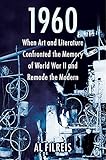1960 : When Art and Literature Confronted the Memory of World War II and Remade the Modern / Al Filreis.
Material type: TextPublisher: New York, NY : Columbia University Press, [2021]Copyright date: 2021Description: 1 online resourceContent type:
TextPublisher: New York, NY : Columbia University Press, [2021]Copyright date: 2021Description: 1 online resourceContent type: - 9780231201841
- 9780231554299
- Avant-garde (Aesthetics) -- History -- 20th century
- Avant-garde (Aesthetics) -- History -- 20th century
- Literature and history -- History -- 20th century
- Literature and history -- History -- 20th century
- Literature, Experimental -- 20th century -- History and criticism
- Literature, Experimental -- 20th century -- History and criticism
- Nineteen sixty, A.D
- Nineteen sixty, A.D
- War Word II 1939-1945 -- Influence
- World War, 1939-1945 -- Influence
- LITERARY CRITICISM / Modern / 20th Century
- 809/.93358 23
- PN50 .F55 2021
- online - DeGruyter
| Item type | Current library | Call number | URL | Status | Notes | Barcode | |
|---|---|---|---|---|---|---|---|
 eBook
eBook
|
Biblioteca "Angelicum" Pont. Univ. S.Tommaso d'Aquino Nuvola online | online - DeGruyter (Browse shelf(Opens below)) | Online access | Not for loan (Accesso limitato) | Accesso per gli utenti autorizzati / Access for authorized users | (dgr)9780231554299 |
Browsing Biblioteca "Angelicum" Pont. Univ. S.Tommaso d'Aquino shelves, Shelving location: Nuvola online Close shelf browser (Hides shelf browser)

|

|

|

|

|

|

|
||
| online - DeGruyter Billy Wilder : Dancing on the Edge / | online - DeGruyter Lumbering State, Restless Society : Egypt in the Modern Era / | online - DeGruyter Camp Century : The Untold Story of America's Secret Arctic Military Base Under the Greenland Ice. | online - DeGruyter 1960 : When Art and Literature Confronted the Memory of World War II and Remade the Modern / | online - DeGruyter The Belle Époque : A Cultural History, Paris and Beyond / | online - DeGruyter The Digital Seeker : A Guide for Digital Teams to Build Winning Experiences / | online - DeGruyter Medical Storyworlds : Health, Illness, and Bodies in Russian and European Literature at the Turn of the Twentieth Century / |
Frontmatter -- Contents -- Preface -- Part 1. Emerging from the Night of the Word -- 1 An Introduction to the Survivor: New Contexts for Genocide -- 2 Pain- Laden Rhymes: Challenges to Narrative and the Radical “Writing I” -- 3 Openings of the Field: Deep Memory and Its Counterwords -- Part 2. The End of the End of Ideology -- 4 Absurd Judgment: Auden, Arendt, Eichmann, and the Kafka Revival -- 5 Oppose the Anti- Everything: Zero Art and the Hopeful Leap -- 6 Adjustment and Its Discontents: Aleatory Art vs. Cold War Deradicalization -- 7 Disaster Defies Utterance: Arts of the Unsayable -- 8 Thaw Poetics: Folk Revival, Radical Unoriginality, and the Old Word Witness -- 9 Abomunism: Wars Within Wars in American Poetry -- 10 Favorite Things -- Notes -- Index
restricted access online access with authorization star
http://purl.org/coar/access_right/c_16ec
In 1960, when World War II might seem to have been receding into history, a number of artists and writers instead turned back to it. They chose to confront the unprecedented horror and mass killing of the war, searching for new creative and political possibilities after the conservatism of the 1950s in the long shadow of genocide.Al Filreis recasts 1960 as a turning point to offer a groundbreaking account of postwar culture. He examines an eclectic group of artistic, literary, and intellectual figures who strove to create a new language to reckon with the trauma of World War II and to imagine a new world. Filreis reflects on the belatedness of this response to the war and the Holocaust and shows how key works linked the legacies of fascism and antisemitism with American racism. In grappling with the memory of the war, he demonstrates, artists reclaimed the radical elements of modernism and brought forth original ideas about testimony to traumatic history.1960 interweaves the lives and works of figures across high and popular culture—including Chinua Achebe, Hannah Arendt, James Baldwin, Amiri Baraka, Paul Celan, John Coltrane, Frantz Fanon, Roberto Rossellini, Muriel Rukeyser, Rod Serling, and Louis Zukofsky—and considers art forms spanning poetry, fiction, memoir, film, painting, sculpture, teleplays, musical theater, and jazz. A deeply interdisciplinary cultural, literary, and intellectual history, this book also offers fresh perspective on the beginning of the 1960s.
Mode of access: Internet via World Wide Web.
In English.
Description based on online resource; title from PDF title page (publisher's Web site, viewed 20. Nov 2024)


